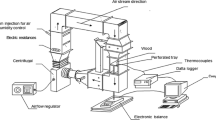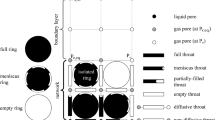Abstract
In the modelling of heat, mass and momentum transfer phenomena which occur in a capillary porous medium during drying, the liquid and gas flows are usually described by the generalised Darcy laws. Nevertheless, the question of how to determine experimentally the relative permeability relations remains unanswered for most materials that consist of water and humid air, and as a result, arbitrary functions are used in the drying codes. In this paper, the emphasis is on deducing from both numerical and experimental studies a method for estimating pertinent relations for these key parameters. In the first part, the sensitivity of liquid velocity and, consequently, of drying kinetics in the variation of the relative permeabilities is investigated numerically by testing various forms. It is concluded that in order to predict a realistic liquid velocity behaviour, relative permeabilities can be linked to a measurable quantity: the capillary pressure. An estimation technique, based on simulations coupled with experimental measurements of capillary pressure, together with moisture content kinetics obtained for low or middle temperature convective drying, is deduced. In the second part, the proposed methodology is applied to pine wood. It is shown that the obtained relations provide closer representation of physical reality than those commonly used.
Similar content being viewed by others
Abbreviations
- AV:
-
averaging volume
- (AV) j :
-
phase volume within the averaging volume AV
- a w :
-
water activity
- B f :
-
resistance factor in the effective diffusitivity coefficient of vapour in the medium
- C :
-
mass fraction of the vapour in the gaseous phase
- C p :
-
constant pressure heat capacity [J kg-1 K-1]
- D :
-
diffusivity [m2 s-1]
- D.C.:
-
convective drying condition assumed to remain constant during the overall process
- F m :
-
total moisture mass flux [kg m-2 s-1]
- g :
-
gravity vector [m s-2]
- h a :
-
intrinsic averaged enthalpy of dry air [J kg-1]: h a = Cp a (T − T r )
- h b :
-
specific averaged enthalpy of bound water [J kg-1]: h b = h l − H b
- \(\bar h_b\) :
-
intrinsic averaged enthalpy of bound water [J kg-1]: \(\bar h_b = h_l - \frac{1}{{\bar \rho _b }}\int_0^{\bar \rho _b } {H_b d(\bar \rho _b )}\)
- h l :
-
intrinsic averaged enthalpy of free water [J kg-1]: h l = Cp l (T − T r )
- h s :
-
intrinsic averaged enthalpy of solid [J kg-1]: h s = CP s (T − T r )
- h v :
-
intrinsic averaged enthalpy of vapour [J kg-1]: h v = H 0 v + Cp v (T − T r )
- H b :
-
heat of desorption [J kg-1]
- H 0 v :
-
latent heat of vaporisation at the reference temperature T r [J kg-1]
- I.C.:
-
Initial conditions of the medium
- J :
-
flux
- k :
-
intrinsic permeability [m2]
- K :
-
volumetric mass rate of evaporation [kg m-3 s-1]
- k r :
-
relative permeability
- L :
-
thickness of the medium [m]
- n :
-
exterior normal unit vector
- P :
-
pressure [Pa]
- q :
-
source term
- Q :
-
total heat flux [W m2]
- RH:
-
external relative humidity [%]
- T :
-
temperature [K or °C]
- T infh :
-
wet bulb temperature [K or °C]
- T r :
-
reference temperature [K]: T r = 273.16 K
- t :
-
time [s]
- S :
-
saturation
- U :
-
conserved quantity
- v :
-
velocity [m s-1]
- W :
-
moisture content (in dry basis)
- z :
-
space variable [m]
- δz :
-
space step [m]
- ε :
-
porosity
- ε j :
-
volume fraction for the phase j: ε j = (AV)j/AV
- Φ :
-
heat source [W m-3]
- λ :
-
effective thermal conductivity [W m-1 K-1]
- μ :
-
dynamic viscosity [kg m-1 s-1]
- ϱ :
-
density [kg m-3]
- τ m :
-
mass transfer coefficient [ms-1]
- τ t :
-
heat transfer coefficient [W m-1 K-1]
- σ :
-
surface tension [N m-1]
- a :
-
dry air
- atm:
-
tmospheric
- b :
-
bound water
- c :
-
capillary
- eq :
-
equilibrium
- g :
-
gas
- inf:
-
drying air
- ini:
-
initial
- irr:
-
irreducible
- l :
-
liquid
- m :
-
macroscopic mean value
- s :
-
solid
- ssp:
-
solid saturation point
- v :
-
vapour
- vsat:
-
saturate vapour
References
Bizot, H., Riou, N. and Multon, J. L., 1987: de pratique pour la détermination des isothermes de sorption et de l'activité de l'eau, Science des aliments, hors serie.
Bonneau, P., 1991: Modélisasion du séchage d'un matériau hétérogène: application à un bois de résineux, Thesis, Univ. of Bordeaux I, France.
Boukadida, N. and Ben Nasrallah, S., 1995: Two dimensional heat and mass transfer during convective drying of porous media, Drying Technol., 13(3), 661–694.
Ceaglske, N. H. and Hougen O.A., 1937: Drying granular solids, Ind. Eng. Chem. 29, 805–817.
Choong, E.T., 1965: Diffusion coefficients of softwoods by steady-state and theoritical methods, Forest Product J. 15(1), 21–27.
Collignan, A., 1988: Elaboration et utilisation d'une cinétique de séchage - Application au pin maritime, Thesis, Univ. of Bordeaux I, France.
Couture, F., 1995: Modélisation fine d'un problème de séchage, développement d'outils adaptés, Thesis, Univ. of Bordeaux I, France.
Couture, F., Fabrie, P. and Puiggali, J.R., 1995: An alternative choice for the drying variables leading to a mathematically and physically well described problem, Drying Technol. 13(3), 519–550.
Cunningham, R. M. and Kelly, J. J., 1978: Liquid transport in drying macroporous material, presented at the 1st International Drying Symposium, Montreal.
Ferguson, W. J. and Turner, I. W., 1994: Unstructured numerical solutions techniques applied to timber drying problems, Proceeding of the 9th International Drying Symposium, B, pp 719–726.
Fyhr, C. and Rasmuson, A., 1994: Numerical simulation of superheated steam drying of wood chips, Proceeding of the 9th International Drying Symposium, B, pp 727–734.
Gobbé, C. and Gounot, J., 1991: Temperature dependent thermal diffusivity measurements by the flash method: application to solids and liquids, High Temperature, High Pressure 23, 509–515.
Hernandez, J. M., 1991: Séchage du chêne, caractérisation, procédés convectif et sous vide, Thesis, Univ. of Bordeaux I, France.
Hornapour, M., Koederitz, L. and Harvey, A. H., 1986: Relative permeability of petroleum reservoirs, CRC Press Inc.
Kaviany, M. and Mittal, M., 1987: Funicular state in drying of a porous slab, Int. J. Heat and Mass Transfer 30(7), 1407–1418.
Kanowsy, P., 1985: Densitometric analysis of a large number of wood samples, J. Institute of Wood Science 4, 145–151.
Lartigue, C. and Puiggali, J. R., 1987: Caractéristiques du pin des landes nécessaires à la compréhension des phénomènes de séchage, Actes du second Coll. Sciences et Industrie du bois, Arbolor Ed. 2, 57–64.
Moyne, C., 1987: Transferts couplés chaleur-masse lors du séchage: prise en compte du mouvement de la phase gazeuse, Thesis, Nancy.
Ouelhazi, N., Arnaud, G. and Forh, J. P., 1992: A two-dimensional study of wood plank drying, the effect of gaseous pressure below boiling point, Tranport in Porous Media 7, 39–61.
Perré, P., 1987a: Le séchage convectif d'un bois résineux, choix, validation et utilisation d'un modèle, Thesis, Univ. of Paris VII, France.
Perré, P., 1987b: Measurements of softwoods'permeability to air: importance upon the drying model, Int. Comm. Heat Mass Transfer 14, 519–529.
Perré, P. and Degiovanni, A., 1990: Simulations par volumes finis des transferts couplés en milieu poreux anisotropes: séchage du bois à basse et à haute temperature, Int. J. Heat and Mass Transfer 33(11), 2463–2478.
Perré, P. and Moyne, C., 1991: Processes related to drying: part II, use of the same model to solve transfers both in saturated and unsaturated porous media, Drying Technol. 9(5), 1153–1179.
Plumb, O. A., Spolek, G. A. and Olmstead, B. A., 1985: Heat and mass transfer in wood during drying, Int. J. Heat and Mass Transfer 28(9), 1669–1678.
Puiggali, J. R. and Quintard, M., 1992: Properties and simplifying assumptions for classical drying models, Advances in Drying, 5, 131–147.
Quintard, M. and Puiggali, J. R., 1986: Numerical modelling of transport processes during the drying of a granular porous medium, Heat and Technology 2(4), 37–57.
Quintard, M. and Whitaker, S., 1993: One- and two-equation models for transient diffusion processes in two-phase system, Advances in Heat Transfer 23, 369–464.
Recan, M., 1982: Simulation numérique du comportement hydrique et thermique d'un sol nu, application à l'étude de l'évaporation par télé-détection, Thèse de Docteur-Ingénieur, I.N.P.T., Toulouse.
Rogers, J. A. and Kaviany, M., 1992: Funicular and evaporative-front regimes in convective drying of granular beds, Int. J. Heat and Mass Transfer 35(2), 469–480.
Spolek, G. A. and Plumb, O. A., 1981: Capillary pressure in softwoods, Wood Sci. Technol. 15, 189–199.
Stanish, M. A., Schager, G. S. and Kayihan, F., 1986: A mathematical modeling of drying for hygroscopic porous media, AIChe J. 32(8), 1301–1311.
Tesoro, F. O., Kimbler, O. V. and Choong, E. T. 1972: Determination of the relative permeability of wood to oil and water, AlChe J. 5(1), 21–26.
Tesoro, F. O., Choong, E. T. and Kimbler, O. V., 1974: Relative permeability and the gross pore structure of wood, Wood and Fiber 6(3), 226–236.
Tsakiroglou, C. D., and Payatakes, A. C., 1990: A new simulator of mercury porosimetry for the characterization of porous materials, J. Colloid Interface Sci. 137(2), 315–339.
Turner, I. W., 1994: A study of the power density distribution generated during the combined microwave and convective drying of softwood, Proceeding of the 9th International Drying Symposium, A, pp 89–111.
Turner, I. W. and Bremhorst, K., 1994: An investigatio, on the effect of neglecting compressible work terms in the energy equation when simulating high temperature and pressure drying processes, Int. Comm. Heat Mass Transfer 21, 661–672.
Turner, I. W. and Ilic, M., 1990: Convective drying of a consolidated slab of wet porous material including the sorption region, Int. Comm. Heat Mass Transfer 17, 39–48.
Whitaker, S., 1977: Simultaneous heat, mass and momentum transfer in porous media: a theory of drying, Advances in Heat Transfer, Vol. 13, Academic Press, New York, pp. 119–203.
Whitaker, S., 1984: Moisture transport mechanisms during the drying of granular porous media, Proceeding of the Fourth International Drying Symposium 1, 31–42.
Whitaker, S., 1991: Improved constraints for the principle of local thermal equilibrium, Ind. Eng. Chem. Res. 30, 983–997.
Whitaker, S. and Chou, W. T. H., 1983–84: Drying of granular porous media - theory and experiment, Drying Technology 1(1), 3–33.
Author information
Authors and Affiliations
Rights and permissions
About this article
Cite this article
Couture, F., Jomaa, W. & Puiggali, JR. Relative permeability relations: A key factor for a drying model. Transp Porous Med 23, 303–335 (1996). https://doi.org/10.1007/BF00167101
Received:
Revised:
Issue Date:
DOI: https://doi.org/10.1007/BF00167101




